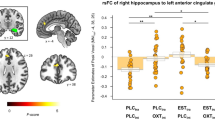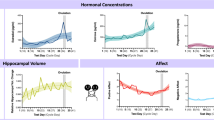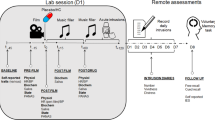Abstract
Women are at relatively greater lifetime risk for depression than men. This elevated risk in women is partly due to heightened risk during time periods characterized by marked fluctuations in sex hormones, including postpartum and perimenopausal periods. How sex hormone fluctuations contribute to heightened risk is not fully understood but may involve intrinsic functional connectivity. We induced a biphasic ovarian sex hormone fluctuation using the gonadotropin-releasing hormone agonist (GnRHa) goserelin to determine, with a randomized placebo-controlled design, intervention effects on or GnRHa-provoked depressive symptoms associations with change in resting-state functional connectivity (rs-FC) in 58 healthy women for six seeds (amygdala, hippocampus, anterior cingulate cortex, dorsal raphe, median raphe, and posterior cingulate cortex). GnRHa intervention did not significantly affect rs-FC in any seeds. Considering the GnRHa group only, the emergence of depressive symptoms following intervention was positively associated with amygdala-right temporal cortex and negatively associated with hippocampus–cingulate rs-FC. A test for mediation suggested that rs-FC changes in these networks marginally mediated the association between decrease in estradiol and increase in depressive symptoms in the GnRHa group (p=0.07). Our findings provide novel evidence-linking changes in rs-FC networks, the emergence of depressive symptoms and sex hormone fluctuations. Notably, we observed evidence that changes in rs-FC may represent a key neurobiological intermediary between molecular changes induced by hormone fluctuations and the emergence of depressive symptoms. Taken together, our findings indicate that sex hormone fluctuations may contribute to heightened risk for developing depressive symptoms by affecting intrinsic functional connectivity of key limbic brain structures.
Similar content being viewed by others
Log in or create a free account to read this content
Gain free access to this article, as well as selected content from this journal and more on nature.com
or
References
Amin Z, Gueorguieva R, Cappiello A, Czarkowski KA, Stiklus S, Anderson GM et al (2006). Estradiol and tryptophan depletion interact to modulate cognition in menopausal women. Neuropsychopharmacology 31: 2489–2497.
Anand A, Li Y, Wang Y, Wu J, Gao S, Bukhari L et al (2005). Activity and connectivity of brain mood regulating circuit in depression: a functional magnetic resonance study. Biol Psychiatry 57: 1079–1088.
Arelin K, Mueller K, Barth C, Rekkas PV, Kratzsch J, Burmann I et al (2015). Progesterone mediates brain functional connectivity changes during the menstrual cycle-a pilot resting state MRI study. Front Neurosci 9: 44.
Baker KG, Halliday GM, Tork I (1990). Cytoarchitecture of the human dorsal raphe nucleus. J Comp Neurol 301: 147–161.
Barth C, Villringer A, Sacher J (2015). Sex hormones affect neurotransmitters and shape the adult female brain during hormonal transition periods. Front Neurosci 9: 37.
Behzadi Y, Restom K, Liau J, Liu TT (2007). A component based noise correction method (CompCor) for BOLD and perfusion based fMRI. Neuroimage 37: 90–101.
Beliveau V, Svarer C, Frokjaer VG, Knudsen GM, Greve DN, Fisher PM (2015). Functional connectivity of the dorsal and median raphe nuclei at rest. Neuroimage 116: 187–195.
Bethea CL, Lu NZ, Gundlah C, Streicher JM (2002). Diverse actions of ovarian steroids in the serotonin neural system. Front Neuroendocrinol 23: 41–100.
Bethea CL, Reddy AP, Tokuyama Y, Henderson JA, Lima FB (2009). Protective actions of ovarian hormones in the serotonin system of macaques. Front Neuroendocrinol 30: 212–238.
Bloch M, Schmidt PJ, Danaceau M, Murphy J, Nieman L, Rubinow DR (2000). Effects of gonadal steroids in women with a history of postpartum depression. Am J Psychiatry 157: 924–930.
Chase HW, Moses-Kolko EL, Zevallos C, Wisner KL, Phillips ML (2013). Disrupted posterior cingulate-amygdala connectivity in postpartum depressed women as measured with resting BOLD fMRI. Soc Cogn Affect Neurosci 9: 1069–1075.
Chase HW, Moses-Kolko EL, Zevallos C, Wisner KL, Phillips ML (2014). Disrupted posterior cingulate-amygdala connectivity in postpartum depressed women as measured with resting BOLD fMRI. Soc Cogn Affect Neurosci 9: 1069–1075.
Comasco E, Frokjaer VG, Sundstrom-Poromaa I (2014). Functional and molecular neuroimaging of menopause and hormone replacement therapy. Front Neurosci 8: 388.
Deligiannidis KM, Sikoglu EM, Shaffer SA, Frederick B, Svenson AE, Kopoyan A et al (2013). GABAergic neuroactive steroids and resting-state functional connectivity in postpartum depression: a preliminary study. J Psychiatr Res 47: 816–828.
Fisher PM, Hariri AR (2012). Linking variability in brain chemistry and circuit function through multimodal human neuroimaging. Genes Brain Behav 11: 633–642.
Fisher PM, Madsen MK, Mc Mahon B, Holst KK, Andersen SB, Laursen HR et al (2014). Three-week bright-light intervention has dose-related effects on threat-related corticolimbic reactivity and functional coupling. Biol Psychiatry 76: 332–339.
Fox MD, Snyder AZ, Vincent JL, Corbetta M, Van Essen DC, Raichle ME (2005). The human brain is intrinsically organized into dynamic, anticorrelated functional networks. Proc Natl Acad Sci USA 102: 9673–9678.
Franco AR, Mannell MV, Calhoun VD, Mayer AR (2013). Impact of analysis methods on the reproducibility and reliability of resting-state networks. Brain Connect 3: 363–374.
Freeman EW, Sammel MD, Boorman DW, Zhang R (2013). Longitudinal pattern of depressive symptoms around natural menopause. JAMA Psychiatry 71: 36–43.
Freeman EW, Sammel MD, Lin H, Nelson DB (2006). Associations of hormones and menopausal status with depressed mood in women with no history of depression. Arch Gen Psychiatry 63: 375–382.
Frokjaer VG, Erritzoe D, Juul A, Nielsen FA, Holst K, Svarer C et al (2010). Endogenous plasma estradiol in healthy men is positively correlated with cerebral cortical serotonin 2A receptor binding. Psychoneuroendocrinology 35: 1311–1320.
Frokjaer VG, Pinborg A, Holst KK, Overgaard A, Henningsson S, Heede M et al (2015). Role of serotonin transporter changes in depressive responses to sex-steroid hormone manipulation: a positron emission tomography study. Biol Psychiatry 78: 534–543.
Gould E, Tanapat P, Rydel T, Hastings N (2000). Regulation of hippocampal neurogenesis in adulthood. Biol Psychiatry 48: 715–720.
Guintivano J, Arad M, Gould TD, Payne JL, Kaminsky ZA (2014). Antenatal prediction of postpartum depression with blood DNA methylation biomarkers. Mol Psychiatry 19: 633.
Henningsson S, Madsen KH, Pinborg A, Heede M, Knudsen GM, Siebner HR et al (2015). Role of emotional processing in depressive responses to sex-hormone manipulation: a pharmacological fMRI study. Transl Psychiatry 5: e688.
Hjelmervik H, Hausmann M, Osnes B, Westerhausen R, Specht K (2014). Resting states are resting traits—-an FMRI study of sex differences and menstrual cycle effects in resting state cognitive control networks. PLoS One 9: e103492.
Kessler RC, McGonagle KA, Swartz M, Blazer DG, Nelson CB (1993). Sex and depression in the National Comorbidity Survey. I: lifetime prevalence, chronicity and recurrence. J Affect Disord 29: 85–96.
Kranz GS, Hahn A, Savli M, Lanzenberger R (2012). Challenges in the differentiation of midbrain raphe nuclei in neuroimaging research. Proc Natl Acad Sci USA 109: E2000.
Lethaby A, Hogervorst E, Richards M, Yesufu A, Yaffe K (2008). Hormone replacement therapy for cognitive function in postmenopausal women. Cochrane Database Syst Rev 23: CD003122.
Lord C, Buss C, Lupien SJ, Pruessner JC (2008). Hippocampal volumes are larger in postmenopausal women using estrogen therapy compared to past users, never users and men: a possible window of opportunity effect. Neurobiol Aging 29: 95–101.
Macoveanu J, Henningsson S, Pinborg A, Jensen P, Knudsen GM, Frokjaer VG et al (2016). Sex-steroid hormone manipulation reduces brain response to reward. Neuropsychopharmacology 41: 1057–1065.
Mehta D, Newport DJ, Frishman G, Kraus L, Rex-Haffner M, Ritchie JC et al (2014). Early predictive biomarkers for postpartum depression point to a role for estrogen receptor signaling. Psychol Med 44: 1–14.
Mehta D, Quast C, Fasching PA, Seifert A, Voigt F, Beckmann MW et al (2012). The 5-HTTLPR polymorphism modulates the influence on environmental stressors on peripartum depression symptoms. J Affect Disord 136: 1192–1197.
Meltzer-Brody S, Boschloo L, Jones I, Sullivan PF, Penninx BW (2013). The EPDS-Lifetime: assessment of lifetime prevalence and risk factors for perinatal depression in a large cohort of depressed women. Arch Womens Ment Health 16: 465–473.
Moses-Kolko EL, Berga SL, Greer PJ, Smith G, Cidis Meltzer C, Drevets WC (2003). Widespread increases of cortical serotonin type 2A receptor availability after hormone therapy in euthymic postmenopausal women. Fertil Steril 80: 554–559.
Moses-Kolko EL, Perlman SB, Wisner KL, James J, Saul AT, Phillips ML (2010). Abnormally reduced dorsomedial prefrontal cortical activity and effective connectivity with amygdala in response to negative emotional faces in postpartum depression. Am J Psychiatry 167: 1373–1380.
Munk-Olsen T, Laursen TM, Pedersen CB, Mors O, Mortensen PB (2006). New parents and mental disorders: a population-based register study. JAMA 296: 2582–2589.
Nutt D, Wilson S, Paterson L (2008). Sleep disorders as core symptoms of depression. Dialogues Clin Neurosci 10: 329–336.
Petersen N, Kilpatrick LA, Goharzad A, Cahill L (2014). Oral contraceptive pill use and menstrual cycle phase are associated with altered resting state functional connectivity. Neuroimage 90: 24–32.
Protopopescu X, Butler T, Pan H, Root J, Altemus M, Polanecsky M et al (2008). Hippocampal structural changes across the menstrual cycle. Hippocampus 18: 985–988.
Sanjuan J, Martin-Santos R, Garcia-Esteve L, Carot JM, Guillamat R, Gutierrez-Zotes A et al (2008). Mood changes after delivery: role of the serotonin transporter gene. Br J Psychiatry 193: 383–388.
Sellers K, Raval P, Srivastava DP (2015). Molecular signature of rapid estrogen regulation of synaptic connectivity and cognition. Front Neuroendocrinol 36: 72–89.
Silverman ME, Loudon H, Liu X, Mauro C, Leiter G, Goldstein MA (2011). The neural processing of negative emotion postpartum: a preliminary study of amygdala function in postpartum depression. Arch Womens Ment Health 14: 355–359.
Vickers AJ, Altman DG (2001). Statistics notes: Analysing controlled trials with baseline and follow up measurements. BMJ 323: 1123–1124.
Whitfield-Gabrieli S, Nieto-Castanon A (2012). Conn: a functional connectivity toolbox for correlated and anticorrelated brain networks. Brain Connect 2: 125–141.
Woolley CS, McEwen BS (1992). Estradiol mediates fluctuation in hippocampal synapse density during the estrous cycle in the adult rat. J Neurosci 12: 2549–2554.
Yankova M, Hart SA, Woolley CS (2001). Estrogen increases synaptic connectivity between single presynaptic inputs and multiple postsynaptic CA1 pyramidal cells: a serial electron-microscopic study. Proc Natl Acad Sci USA 98: 3525–3530.
Acknowledgements
Findings herein were presented as a poster entitled Resting State Functional Connectivity Signatures of Pharmacologically Induced Sex Hormone Fluctuations in a Risk Model for Depression at the 2015 Society of Biological Psychiatry meeting in Toronto, Canada. We wish to thank Elisabeth C. Larsen, Dorthe Givard, Agnete Dyssegaard, Anna Pors Nielsen, and Kenda Christensen for superb technical assistance.
Author information
Authors and Affiliations
Corresponding author
Rights and permissions
About this article
Cite this article
Fisher, P., Larsen, C., Beliveau, V. et al. Pharmacologically Induced Sex Hormone Fluctuation Effects on Resting-State Functional Connectivity in a Risk Model for Depression: A Randomized Trial. Neuropsychopharmacol 42, 446–453 (2017). https://doi.org/10.1038/npp.2016.208
Received:
Revised:
Accepted:
Published:
Issue date:
DOI: https://doi.org/10.1038/npp.2016.208
This article is cited by
-
Leveraging research into sex differences and steroid hormones to improve brain health
Nature Reviews Endocrinology (2025)
-
Effects of Chaihu Shugan San on Brain Functional Network Connectivity in the Hippocampus of a Perimenopausal Depression Rat Model
Molecular Neurobiology (2024)
-
Effects of exogenous oxytocin and estradiol on resting-state functional connectivity in women and men
Scientific Reports (2023)
-
Cognitive processing of emotional information during menstrual phases in women with and without postpartum depression: differential sensitivity to changes in gonadal steroids
Archives of Women's Mental Health (2022)
-
In search of sex-related mediators of affective illness
Biology of Sex Differences (2021)



